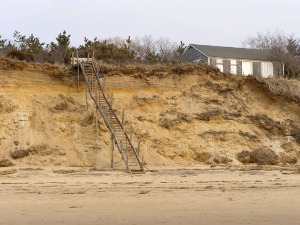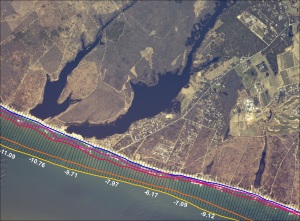“Cape homes, beaches losing ground” – CCT, 03.19.10
“Lower Cape beaches battered” – CCT, 03.09.10
“Wind and waves batter beaches” – CCT, 02.27.10
“North Beach inlet erosion threatens property owners” – CCT, 01.27.10
“Storm speeds Truro erosion” – CCT, 01.06.10
“Nantucket home succumbs to the sea” – CCT, 12.16.09
“North Beach cottage succumbs to storm” – CCT, 10.19.09
 It has been a stormy winter here on the Cape, and a walk along the beach will confirm this claim if the onslaught of newspaper articles is not convincing enough. But while this season may have been a dramatic one, the general trend is not new or particularly surprising. The historical and projected future pattern of shoreline erosion is worthy of our attention since the damage is tangible and has both economic and environmental implications. Some states, including Massachusetts, currently lack the initiative and financial support to appropriately manage their shorelines.
It has been a stormy winter here on the Cape, and a walk along the beach will confirm this claim if the onslaught of newspaper articles is not convincing enough. But while this season may have been a dramatic one, the general trend is not new or particularly surprising. The historical and projected future pattern of shoreline erosion is worthy of our attention since the damage is tangible and has both economic and environmental implications. Some states, including Massachusetts, currently lack the initiative and financial support to appropriately manage their shorelines.
In this first installment of 2Fathom, we will look at coastal erosion issues in a series of five entries. First we will define the issue and talk about current trends. Next we will discuss why our beaches are worth protecting. Then, we’ll talk about the engineering options for protecting our beaches and coastlines, and the limitations and consequences of these measures. Finally we’ll put forth our ideas, as technical practitioners, about how to best enable the appropriate management of our beaches and coastlines.
The fact is that coastal systems are dynamic. Shorelines and beaches are constantly gaining and losing ground, and this is a natural process. Erosion of coastal landforms supplies sand to beaches and dunes. These sands are transported by wind, waves and currents along the shoreline and then out to sea. In a typical year beaches will accrete gradually during the summer, when gentle waves deposit sediments onto the shore, unless a hurricane hits. Beaches then erode considerably during the winter, when storm waves impact the coastline and drag sand offshore.
The ebb and flow of coastal land occurs naturally, but much of our coastline has been radically altered by intense development. Poorly planned coastal development contributes to shoreline erosion by inhibiting the supply of sand to the coastline and interrupting the natural flow of sediment along the shore. As natural erosion causes the shoreline to retreat and threatens upland infrastructure, measures (such as coastal structures) have been installed to stave off local erosion. Poorly designed and maintained structures disrupt the natural equilibrium of the coastline and result in cascading effects to downdrift beaches, dunes, salt marshes and estuaries. When we head out into the field for site investigations, we witness these factors interacting with coastal storms and relative sea-level rise in a trifecta of land larceny.
What does all of this mean, then? How is it all playing out along our coastlines? Overall, our shorelines are eroding. They are eroding at an alarming rate.
 The Massachusetts Office of Coastal Zone Management (CZM) Shoreline Change Project used historical maps and aerial photographs to document changes in the Massachusetts shoreline position between 1844 and 1994. CZM developed 30,300 transects to statistically analyze the short-term and long-term shoreline erosion rates. CZM data indicates that over the past twenty years, the Massachusetts shoreline has been eroding up to 3 ft/yr on average. Particularly vulnerable sections of the coast, like Nantucket, have eroded more than 5 ft/yr on average during this time period. A Sea Grant Woods Hole report found that 68% (513 miles) of the Massachusetts shoreline was exhibiting long-term erosional trends. Towns on Cape Cod and the Islands experienced long-term erosion rates of up to 3.7 ft/yr. Although a 3 ft/yr average may not seem like a lot, the actual erosion typically occurs as episodic, large and noticeable events. Over 100 years, 3 ft/yr equates to a loss the length of a football field. This certainly brings the force of the ocean much closer to public roads and other infrastructure.
The Massachusetts Office of Coastal Zone Management (CZM) Shoreline Change Project used historical maps and aerial photographs to document changes in the Massachusetts shoreline position between 1844 and 1994. CZM developed 30,300 transects to statistically analyze the short-term and long-term shoreline erosion rates. CZM data indicates that over the past twenty years, the Massachusetts shoreline has been eroding up to 3 ft/yr on average. Particularly vulnerable sections of the coast, like Nantucket, have eroded more than 5 ft/yr on average during this time period. A Sea Grant Woods Hole report found that 68% (513 miles) of the Massachusetts shoreline was exhibiting long-term erosional trends. Towns on Cape Cod and the Islands experienced long-term erosion rates of up to 3.7 ft/yr. Although a 3 ft/yr average may not seem like a lot, the actual erosion typically occurs as episodic, large and noticeable events. Over 100 years, 3 ft/yr equates to a loss the length of a football field. This certainly brings the force of the ocean much closer to public roads and other infrastructure.
While the beach migrates back and forth each year, these long-term erosional trends show that Massachusetts is losing ground. Here on Cape Cod, we are losing approximately 33 acres of land each year. Approximately 24 acres are lost to passive submergence of the upland areas due to sea-level rise, and 9 acres are lost to active erosion of sea cliffs (Giese, 1997).
That’s a sizeable loss of land and beach, which translates to significant losses to the environment, economy, and enjoyment of beachgoers in coastal communities. Later 2Fathom entries will review what we at Woods Hole Group believe can be done to manage the important issue of beach erosion.

I am the superintendent for the beaches in Chilmark on Martha’s Vineyard. This is the worst I have ever seen I have work on the beaches for 16 years. I have photos and I just got approval to do planting from con com. I am also planning on using somthing I call the brush Box. Our department doesn’t have any money so I had the thought to use what is free, If I can produce a brochure to inform the patrons about our efforts to slow down the erosion we may get donations.
We are familiar with practices such as brush mattressing and live cribwalls, which sound similar to your “brush boxes”. Though we haven’t specified these in our designs (we find that plantings and sand fences are highly effective), we would be interested in hearing about your experience.
How did the planting turn out? How have your beaches held up so far this winter?